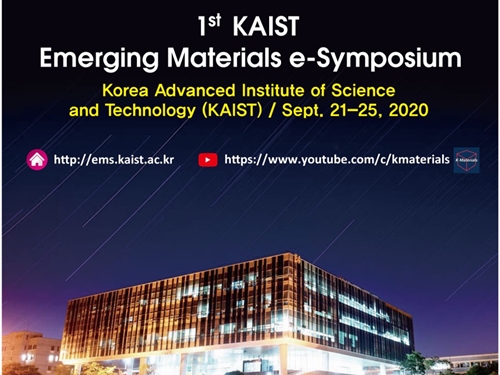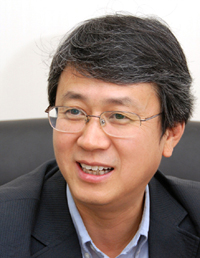Stanford+University
-
 Big Ideas on Emerging Materials Explored at EMS
Renowned scholars and editors from academic journals joined the Emerging Materials e-Symposium (EMS) held at KAIST and shared the latest breakthroughs and big ideas in new material development last month. This e-symposium was organized by Professor Il-Doo Kim from the KAIST Department of Materials Sciences and Engineering over five days from September 21 through 25 via Zoom and YouTube. Professor Kim also serves as an associate editor of ACS Nano.
Esteemed scholars and editors of academic journals including ACS Nano, Nano Energy, and Energy Storage Materials made Zoom presentations in three main categories: 1) nanostructures for next-generation applications, 2) chemistry and biotechnology for applications in the fields of environment and industry, and 3) material innovation for technological applications.
During Session I, speakers including Professor John A. Rogers of Northwestern University and Professor Zhenan Bao of Stanford University led the session on Emerging Soft Electronics and 3D printing.
In later sessions, other globally recognized scholars gave talks titled Advanced Nanostructuring for Emerging Materials, Frontiers in Emerging Materials Research, Advanced Energy Materials and Functional Nanomaterials, and Latest Advances in Nanomaterials Research.
These included 2010 Nobel Prize laureate and professor at Manchester University Andre Geim, editor-in-chief of ACS Nano and professor at UCLA Paul S. Weiss, Professor Paul Alivisatos of UC Berkeley, Professor William Chueh of Stanford University, and Professor Mircea Dinca of MIT.
KAIST President Sung-Chul Shin, who is also a materials physicist, said in his opening address, “Innovation in materials science will become an important driving force to change our way of life. All the breakthroughs in materials have extended a new paradigm that has transformed our lives.”
“Creative research projects alongside global collaborators like all of you will allow the breakthroughs that will deliver us from these crises,” he added.
(END)
2020.10.06 View 15980
Big Ideas on Emerging Materials Explored at EMS
Renowned scholars and editors from academic journals joined the Emerging Materials e-Symposium (EMS) held at KAIST and shared the latest breakthroughs and big ideas in new material development last month. This e-symposium was organized by Professor Il-Doo Kim from the KAIST Department of Materials Sciences and Engineering over five days from September 21 through 25 via Zoom and YouTube. Professor Kim also serves as an associate editor of ACS Nano.
Esteemed scholars and editors of academic journals including ACS Nano, Nano Energy, and Energy Storage Materials made Zoom presentations in three main categories: 1) nanostructures for next-generation applications, 2) chemistry and biotechnology for applications in the fields of environment and industry, and 3) material innovation for technological applications.
During Session I, speakers including Professor John A. Rogers of Northwestern University and Professor Zhenan Bao of Stanford University led the session on Emerging Soft Electronics and 3D printing.
In later sessions, other globally recognized scholars gave talks titled Advanced Nanostructuring for Emerging Materials, Frontiers in Emerging Materials Research, Advanced Energy Materials and Functional Nanomaterials, and Latest Advances in Nanomaterials Research.
These included 2010 Nobel Prize laureate and professor at Manchester University Andre Geim, editor-in-chief of ACS Nano and professor at UCLA Paul S. Weiss, Professor Paul Alivisatos of UC Berkeley, Professor William Chueh of Stanford University, and Professor Mircea Dinca of MIT.
KAIST President Sung-Chul Shin, who is also a materials physicist, said in his opening address, “Innovation in materials science will become an important driving force to change our way of life. All the breakthroughs in materials have extended a new paradigm that has transformed our lives.”
“Creative research projects alongside global collaborators like all of you will allow the breakthroughs that will deliver us from these crises,” he added.
(END)
2020.10.06 View 15980 -
 World Research University Heads to Discuss Challenges in Global Financial Turmoil
About 70 leaders of the world"s major research universities will discuss how to better contribute to continued development of human society in global financial turmoil at a symposium organized by KAIST Monday (Sept. 21) at the Westin Chosun Hotel in Seoul.
Participants of the 2nd International Presidential Forum on Global Research Universities are from 40 universities in 25 countries, including Stanford University and Georgia Institute of Technology of the United States, Berlin Institute of Technology of Germany, Paris Institute of Technology of France, Technical University of Denmark, National University of Singapore and Tokyo Institute of Technology. They include 20 presidents of Korean universities and two dozens of leaders from industry and the government.
Under the main subject of "Challenges to Global Research Universities," the international symposium will proceed in four panel sessions. The subjects of each session and their keynote speakers are:
-- "Institutional Management in Times of Financial Crisis" by Kurt Kutzler, President of Berlin Institute of Technology
-- "Innovations in Education & Research" by Brian Cantor, Vice Chancellor of University of York
-- "Globalization of Institutes of Higher Learning" by Gary Schuster, Provost and Executive Vice President of Georgia Institute of Technology
-- "The Roles of Government, University and Industry in Green Technology Development" by KAIST President Nam-Pyo Suh
KAIST President Suh said of the purpose of the conference: "The world has witnessed a global financial turmoil of unseen magnitude and many nations are still struggling under the devastating impacts. While universities were no exception in facing economic turmoil, they have realized renewed pressures and expectations from their respective communities to provide answers to the great challenges."
"The conference will serve as an opportunity for the representatives of research universities to compare their visions of networking among theier institutions and initiate steps for new relationships. The conference I am sure will have a far-reaching influence on the course our research universities will take to shoulder greater responsibilities for building a better future of the mankind."
For more information, visit forum.kaist.ac.kr
2009.09.16 View 18139
World Research University Heads to Discuss Challenges in Global Financial Turmoil
About 70 leaders of the world"s major research universities will discuss how to better contribute to continued development of human society in global financial turmoil at a symposium organized by KAIST Monday (Sept. 21) at the Westin Chosun Hotel in Seoul.
Participants of the 2nd International Presidential Forum on Global Research Universities are from 40 universities in 25 countries, including Stanford University and Georgia Institute of Technology of the United States, Berlin Institute of Technology of Germany, Paris Institute of Technology of France, Technical University of Denmark, National University of Singapore and Tokyo Institute of Technology. They include 20 presidents of Korean universities and two dozens of leaders from industry and the government.
Under the main subject of "Challenges to Global Research Universities," the international symposium will proceed in four panel sessions. The subjects of each session and their keynote speakers are:
-- "Institutional Management in Times of Financial Crisis" by Kurt Kutzler, President of Berlin Institute of Technology
-- "Innovations in Education & Research" by Brian Cantor, Vice Chancellor of University of York
-- "Globalization of Institutes of Higher Learning" by Gary Schuster, Provost and Executive Vice President of Georgia Institute of Technology
-- "The Roles of Government, University and Industry in Green Technology Development" by KAIST President Nam-Pyo Suh
KAIST President Suh said of the purpose of the conference: "The world has witnessed a global financial turmoil of unseen magnitude and many nations are still struggling under the devastating impacts. While universities were no exception in facing economic turmoil, they have realized renewed pressures and expectations from their respective communities to provide answers to the great challenges."
"The conference will serve as an opportunity for the representatives of research universities to compare their visions of networking among theier institutions and initiate steps for new relationships. The conference I am sure will have a far-reaching influence on the course our research universities will take to shoulder greater responsibilities for building a better future of the mankind."
For more information, visit forum.kaist.ac.kr
2009.09.16 View 18139 -
 Method to Synthesize New Lithium Ion Battery Cathode Material Identified
A KAIST research team headed by Prof. Do-Kyung Kim at the Department of Materials Science and Engineering developed a technology to synthesize a new lithium ion battery spinel cathode which is regarded as a core part of hybrid and lithium battery cars.
The research was conducted in collaboration with a research team of Prof. Yi Cui at Stanford University"s Department of Chemistry. Their findings were introduced in the November issue of Nano Letters, one of the leading academic journals in nano-science.
The newly synthesized lithium ion battery spinel cathode known as spinel LiMn2O4 nanorods is attracting interests as an alternative cathode material since it is a low-cost, environmentally friendly substance for Li-ion battery cathodes. Its raw material is also highly available.
Lithium ion batteries with high energy and power density are important for consumer electronic devices, portable power tools, and vehicle electrification. LixCoO2 is a commonly used cathode material in commercial lithium iron batteries. However, the high cost, toxicity, and limited abundance of cobalt have been recognized to be disadvantageous.
2008.11.20 View 13767
Method to Synthesize New Lithium Ion Battery Cathode Material Identified
A KAIST research team headed by Prof. Do-Kyung Kim at the Department of Materials Science and Engineering developed a technology to synthesize a new lithium ion battery spinel cathode which is regarded as a core part of hybrid and lithium battery cars.
The research was conducted in collaboration with a research team of Prof. Yi Cui at Stanford University"s Department of Chemistry. Their findings were introduced in the November issue of Nano Letters, one of the leading academic journals in nano-science.
The newly synthesized lithium ion battery spinel cathode known as spinel LiMn2O4 nanorods is attracting interests as an alternative cathode material since it is a low-cost, environmentally friendly substance for Li-ion battery cathodes. Its raw material is also highly available.
Lithium ion batteries with high energy and power density are important for consumer electronic devices, portable power tools, and vehicle electrification. LixCoO2 is a commonly used cathode material in commercial lithium iron batteries. However, the high cost, toxicity, and limited abundance of cobalt have been recognized to be disadvantageous.
2008.11.20 View 13767